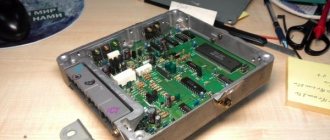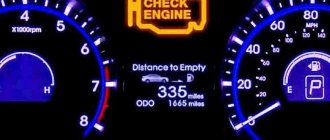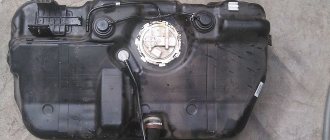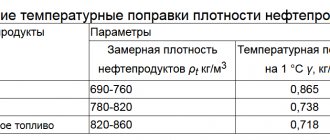Every motorist has faced this question at least once in his life. All modern cars have a special light on the dashboard, signaling to the driver that the fuel level has reached the minimum level. However, the indicator light does not mean that the car will immediately stall, because there is still a certain amount of fuel left in the tank.
instrument panel
An indication of the need to refuel is usually accompanied by a single sound signal.
Hear this “ding” - start counting. An indication of the need to refuel is usually accompanied by a single sound signal. Hear this “ding” - start counting.
It would seem, what is there to talk about? Information about the reserve in the fuel tank should be contained in the vehicle's operating manual. Or even simpler: the trip computer warns about low fuel levels and tells you how far you can drive before refueling. Not always. Others give out only dashes instead of specific numbers, causing you to panic even more.
However, the authors of instructions often limit themselves to general words. For example, “the low fuel warning light comes on when the fuel tank is almost empty.” This is a quote from the Hyundai Solaris and Kia Rio operating manuals. It even contains an element of drama: “Running out of fuel may endanger the occupants of the vehicle.” Scary…
What does the “light bulb” mean?
Why shouldn't you let the tank empty?
The fuel level drops, the pump tries hard to pump in the remains, its body is completely exposed and begins to heat up. This has a very negative effect on it; if you like, such overheating can cause its failure.
Remember a simple truth - do not reach a dry tank! This negatively affects the fuel pump. As soon as the light comes on, you need to immediately go to the gas station and fill up with fuel.
In a good way, make it a rule not to even reach the lamp; as soon as the fuel level has dropped, but the lamp is not yet on, we go to the gas station. Thus, the pump will always be in gasoline and cool properly.
Now we are watching a short video.
I’ll finish this, yes, the article is easy, but useful for beginners. Read our AUTOBLOG.
Similar news
- What and how to glue the rear view mirror? On the windshield, under...
- Why buy old batteries?
- The battery is dead, how to start the car?
Add a comment Cancel reply
refilling gasoline
If you have to travel outside the city, keep a small can of fuel in the trunk just in case.
Check that it closes tightly. It is more convenient when it is equipped with a watering can for refilling. Like in this illustration, for example. If you have to travel outside the city, keep a small can of fuel in the trunk just in case. Check that it closes tightly. It is more convenient when it is equipped with a watering can for refilling. Like in this illustration, for example.
Meanwhile, “drying out” is bad: you can find a lot of unpleasant adventures both for yourself and for the car. For example, burn out a fuel pump that will not have enough cooling. In addition, it will begin to pick up dirt that is in the tank of any car with high mileage. A lean mixture may damage the catalytic converter. When the engine is running at high speeds and the fuel mixture stops flowing into it (for example, in a long turn), this can lead to detonation and subsequent repairs. If it happens in a mountainous area, there is a risk of not being able to overcome the climb. And in general, any forced stop far from civilization is unsafe. In winter, you can simply freeze, afraid to leave the car. Do you think it's fiction? Alas, this happens. And not only in Siberia and the Far East, but even in central Russia. By the way, read in your spare time how to survive in this case.
What is backup fuel
This term may not be familiar to every driver, which is why we need to make a small digression and give it an explanation. Reserve fuel is the amount of gasoline that remains in the tank after the light on the dashboard is activated. This level is different for each car; it can differ significantly in cars from different manufacturers. There is no single standard in the world, so each automaker sets the level of reserve gasoline independently.
You can find out how much gasoline remains after the light comes on in a short time. It's very simple, but you do need to have the vehicle's manual handy. Each specification specifies the technical characteristics of the fuel tank. Next to this data there is a number that corresponds to the volume of reserve fuel.
aerodynamics
A common feature of the champions in terms of efficiency (among them is the Volkswagen XL1, which consumes only a liter of fuel per 100 km) is impeccable streamlining.
A common feature of the champions in terms of efficiency (among them is the Volkswagen XL1, which consumes only a liter of fuel per 100 km) is impeccable streamlining.
We crawl, hobble in the darkness...
How to get to the gas station? Close the windows to improve aerodynamics and turn off the air conditioning if possible (air conditioning is a serious energy consumer). There's no point in turning off the music; she won't eat much. Leave the headlights on too - otherwise you will save on safety, which you cannot do, no matter what happens. You need to move as evenly as possible, without sudden acceleration and braking, in top gear, at a speed of about 80 km/h (not in populated areas). In 2008, our editor traveled to St. Petersburg and back on one tank, driving a 170-horsepower Volvo.
Types of indicators
In cars equipped with a carburetor system, the power supply for the warning light depends on the fuel level sensor. In other words, the sensor and the lamp are connected. The operating principle is simple. When a certain level of gasoline is reached, the slider of the device closes the contacts and the light comes on. Everyone noticed that the light bulb burned intermittently at first. This is due to the splashing of gasoline in the tank. But when there is very little of it, the light bulb begins to burn constantly. Modern cars are mostly fuel-injected. The signal lamp is powered by a special sensor on the pump body. It consists of a metal flask with a thermistor inside. The principle is this: under the influence of temperature, the resistance of the thermistor changes.
user manual
Page from the Lada 4×4 (ex-Niva) instruction manual.
Everything is clear and extremely clear. Page from the Lada 4×4 (ex-Niva) instruction manual. Everything is clear and extremely clear.
| brand, model | Fuel reserve as specified in the operating manual | Notes |
| Hyundai Solaris | No data, "the warning light comes on when the fuel tank is almost empty." | According to users, Solaris has at least 7 liters in reserve, which should be enough for 100 km on a country road. |
| Kia Rio | Likewise | Likewise |
| Volkswagen Polo | “It constantly burns with fuel remaining in the tank for about 80 km.” | And here, according to users, the reserve is 7–8 liters, no less than 100 km. |
| Skoda Rapid | “The warning light comes on when there is approximately less than 7 liters of fuel left in the tank” | Rapid has several powertrain options. But even in the most powerful version, the reserve should be enough for more than 100 km. |
| Renault Duster | There is no data “if the lamp lights up and does not go out, it is necessary to urgently fill the tank with fuel.” | According to the owners, a reserve of at least 7 liters (often said about 8 liters) should be enough for 90 km. |
| Renault Logan | Likewise | The reserve is about 5 liters, should be enough for 90 km. |
| Lada Largus | Likewise | Likewise |
| Renault Sandero | “From the moment the warning light first comes on, you can drive another 50 km.” | In fact, the reserve in the tank is at least 5 liters, perhaps 7. |
| Lada Granta | No data, “illuminates yellow when refueling is required to avoid engine interruptions.” | The owners claim that the reserve is about 8 liters. More than 100 km of travel! |
| Lada Kalina | Likewise | Likewise |
| Lada Vesta | No data, the corresponding item in the instruction manual could not be found. | The reserve is 7–8 liters, also for 100 km or more. |
| Lada XRAY | “From the moment the warning light first comes on, you can drive about 50 km.” | The reserve in the tank is 6–7 liters of fuel. Like Renault Sandero. |
| Lada 4×4 | “Lights up orange when there is less than 4-6.5 liters left in the fuel tank.” | "Niva", that is, Lada 4x4, is not the most economical car. The minimum consumption, according to the passport data, is 9.1 liters. per 100 km. In total, you have less than 90 km left. Alas. |
| Chevrolet Niva | Likewise | Likewise |
| Toyota Camry | “Indicates approximately 10.5 liters of fuel or less remaining.” | This reserve should be enough for another 100 km! |
| Toyota RAV4 | “Indicates that the remaining fuel is 9.0 L or less.” | The minimum fuel consumption on the highway for the version with a 2.0-liter engine is 6.3 liters per 100 km. But don’t delude yourself and take risks. Refuel as soon as possible. |
Study: How far can you drive a light bulb?
How long can you drive with a light on?
The answer to this question is not as simple as it seems. The fact is that despite all the modern technological breakthroughs, not a single electronic system can tell with 100% accuracy how much fuel is in the tank until the moment the car stops and stalls.
A car's fuel consumption is a dynamic indicator - it is strongly influenced by many factors: the driver's driving style, the topography of the road and the route itself, the vehicle's load, as well as its general "appetite" and the operation of additional devices, including air conditioning, an audio system and others.
Why a gasoline sensor may give incorrect readings
Removing and installing the Renault Logan engine flywheel
A dial indicator may produce incorrect data; there are three main reasons for defects:
- the device itself, located on the dashboard, does not work;
- there is a short circuit or break in the wiring;
- There are shortcomings in the float fuel level sensor (FLS), which is located in the gas tank.
Let's look at how to check the sensor readings on a VAZ-2115 car. The FLS on a car is located in the gas tank, under the right, to check it, you first need to get to the wiring. We do this:
Affiliate program The best for making money on YouTube join.quizgroup.com?ref=160705 Earning money on the web without.
- remove the lower part of the rear sofa;
- pull off the plug from the electric fuel pump;
- turn on the ignition - the pointer of the device in this case should not deviate, because power is not supplied to the pointer device;
- Next, connect the pink wire in the connector to ground, the device arrow should rise up to one;
- if the needle deviated to one when the ignition was turned on and the pink wire was shorted to ground, and when the plug was removed it was in the lower “zero” position, this means that the wiring and the sensor itself on the instrument panel are working properly, the breakdown is hidden in the FLS;
- Next, you need to check the sensor; to do this, unscrew the fuel pump mounting nuts, remove the gasoline fittings and the pressure plate of the pump;
- After removing the used pump, you need to carefully examine the conductive path on the sensor; perhaps there is a break on it - over time, the path may fray. Often the float falls off the fuel pump, and the fuel level readings will also be incorrect.
Why a gasoline sensor may give incorrect readings
A dial indicator may produce incorrect data; there are three main reasons for defects:
- the device itself, located on the dashboard, does not work;
- there is a short circuit or break in the wiring;
- There are shortcomings in the float fuel level
(FLS), which is located in the gas tank.
Let's look at how to check the sensor readings on a VAZ-2115 car. The FLS on a car is located in the gas tank, under the rear seat on the right, to check it, you first need to get to the wiring. We do this:
After disassembling the instrument panel
How to correctly set the fuel level arrow.
- remove the lower part of the rear sofa;
- pull off the plug from the electric fuel pump;
- turn on the ignition - in this case the instrument needle should not deviate, since power is not supplied to the pointer instrument;
- Next, connect the pink wire in the connector to ground, the instrument needle should rise up to one;
- if the arrow deviated to one when the ignition was turned on and the pink wire was shorted to ground, and when the plug was removed it was in the lower “zero” position, this means that the wiring and the sensor itself on the instrument panel are working, the breakdown is hidden in the FLS;
- Next, you need to check the sensor; to do this, unscrew the fuel pump mounting nuts, remove the gasoline fittings, and the pump pressure plate;
- After removing the used pump, you need to carefully inspect the conductive path on the sensor; perhaps there is a break on it - over time, the path may fray. It is also common for a float to fall off the fuel pump, and the fuel level
will also be incorrect.
How to check the fuel level indicator on a Chevrolet Aveo
There is often a situation where the fuel level
constantly lights up no matter how much gasoline is poured into the tank. We check the sensors on the car as follows:
- we get to the fuel pump by removing the hatch and disconnecting the sensor plug;
- We connect a multimeter (ohmmeter) to the middle lower and middle upper connectors on the sensor in the gas tank; the measuring device should show about 200 ohms if the FLS is working properly. If the resistance is infinite, there is an open circuit in the sensor circuit; if it is too small, there is a short circuit;
- we check the indicator light on the instrument panel using a wire, we also bridge the middle connectors in the removed plug (to which the yellow and black wires go);
- when the wires are shorted, the lamp on the instrument panel should light up brightly; if this does not happen, there is probably a problem with the wiring, or the lamp itself has burned out;
- Having removed the fuel pump, we also check the condition of the FLS by external inspection; for convenience, you can remove the float;
Main problems of the fuel level
– faulty thermistor.
This resistor is connected by an electrical circuit (black and yellow wires) to a light bulb; when its resistance decreases, the light on the instrument panel
lights up.
The gasoline around the thermistor cools the sensor, the resistance at this moment is high, and the lamp does not light up. As soon as there is less gasoline, the resistance drops on the instrument panel
fuel level
indicator lights up .
It is not necessary to install a branded thermistor; it can be selected from those parts that are sold in radio stores, and here it is important that its resistance is 200 Ohms. We change the sensor like this:
- disassemble the cone;
- bend one end of the thermistor, solder it to the textolite pad (black wire in the figure above);
- the second tap will connect to the bottom of the flask; it must be threaded through the cylinder;
- We roll up the textolite pad in the case, now all that remains is to solder the wires to the cone and install the homemade sensor in place.
Then we put the fuel pump in place, check the operation of the gasoline level indicator on the instrument panel, the lamp should work properly.










